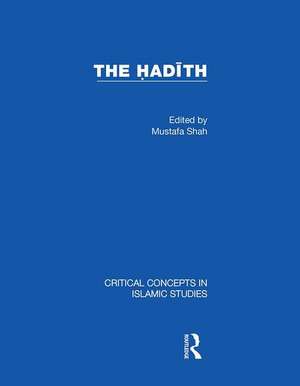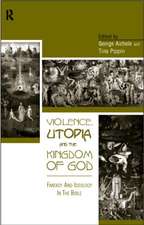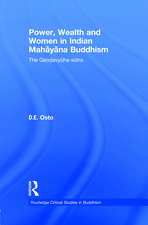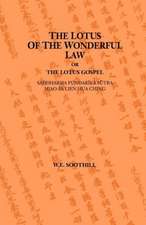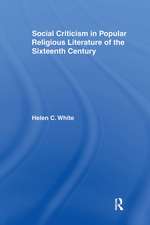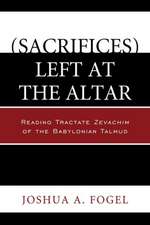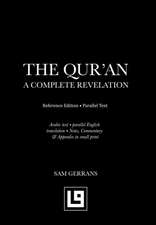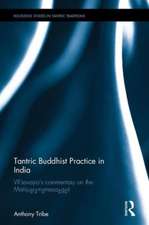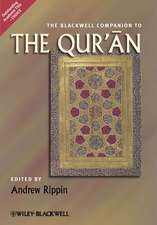The Hadith: Articulating the Beliefs and Constructs of Classical Islam: Critical Concepts in Islamic Studies
Editat de Mustafa Shahen Limba Engleză Hardback – 29 oct 2009
The collection features an accessible and informative introduction which presents an outline of the significance of the hadiths within the religious tradition while also reviewing classical scholarship devoted to the literature of the traditions; moreover, the introduction decisively sets into context the academic debates and arguments which are fleshed out in the articles selected. It also charts developments in the academic study of hadiths, summing up the current state of the field and features a detailed bibliography listing primary classical sources germane to the field of Prophetic traditions together with recent research monographs and articles devoted to the subject.
This Major Work provides an authoritative collection of the seminal research articles produced by western academic scholarship on the subject of the hadith over the past century, including recent papers on the subject. In bringing together the finest examples of scholarship devoted to the hadith and the classical literature that surrounds it, these volumes provide an indispensable reference resource for academics, research institutions, governmental organizations, and those with a general interest in Arabic and Islamic Studies, Religious Studies, Arabic Cultural Studies, and Middle East History.
Din seria Critical Concepts in Islamic Studies
- 34%
 Preț: 4239.15 lei
Preț: 4239.15 lei - 34%
 Preț: 6741.77 lei
Preț: 6741.77 lei - 33%
 Preț: 1279.94 lei
Preț: 1279.94 lei - 34%
 Preț: 5482.50 lei
Preț: 5482.50 lei - 34%
 Preț: 6189.19 lei
Preț: 6189.19 lei - 34%
 Preț: 4924.98 lei
Preț: 4924.98 lei - 34%
 Preț: 6183.03 lei
Preț: 6183.03 lei - 34%
 Preț: 3961.32 lei
Preț: 3961.32 lei - 34%
 Preț: 5486.58 lei
Preț: 5486.58 lei - 34%
 Preț: 6188.11 lei
Preț: 6188.11 lei - 34%
 Preț: 6191.18 lei
Preț: 6191.18 lei - 34%
 Preț: 4233.57 lei
Preț: 4233.57 lei - 33%
 Preț: 3697.55 lei
Preț: 3697.55 lei - 34%
 Preț: 6186.14 lei
Preț: 6186.14 lei - 34%
 Preț: 6739.46 lei
Preț: 6739.46 lei - 34%
 Preț: 6173.50 lei
Preț: 6173.50 lei - 34%
 Preț: 7295.07 lei
Preț: 7295.07 lei
Preț: 4378.50 lei
Preț vechi: 6822.70 lei
-36% Nou
Puncte Express: 6568
Preț estimativ în valută:
837.84€ • 876.97$ • 697.34£
837.84€ • 876.97$ • 697.34£
Carte tipărită la comandă
Livrare economică 31 martie-14 aprilie
Preluare comenzi: 021 569.72.76
Specificații
ISBN-13: 9780415473989
ISBN-10: 0415473985
Pagini: 1704
Dimensiuni: 156 x 234 x 118 mm
Greutate: 3.31 kg
Ediția:New.
Editura: Taylor & Francis
Colecția Routledge
Seria Critical Concepts in Islamic Studies
Locul publicării:Oxford, United Kingdom
ISBN-10: 0415473985
Pagini: 1704
Dimensiuni: 156 x 234 x 118 mm
Greutate: 3.31 kg
Ediția:New.
Editura: Taylor & Francis
Colecția Routledge
Seria Critical Concepts in Islamic Studies
Locul publicării:Oxford, United Kingdom
Cuprins
Volume I: Hadith: Codification, Authenticity Volume II: Isnads: Transmission, Terminology, and The Issue of Dating Volume III: Hadith: Scholarship, Perspectives, and Criticism Volume IV: Hadith: Narrative, Context, and Content
Recenzii
The Ḥadīth. Edited by Mustafa Shah. Critical Concepts in Islamic Studies. London:
Routledge, 2009. Pp. 1,704. £650.00.
This is a magnificent collection of essays on the subject of ḥadīth scholarship. The
Routledge series of ‘Critical Concepts in Islamic Studies’, for those who are
unfamiliar with the format, marks an important new initiative in the publication of
material on the subject. Unlike the Variorum presentation with which most of us have
long been familiar, the articles in these volumes are completely re-typeset in a
common format and each volume is continuously paginated, all of which gives a
much greater homogeneity and elegance to the whole. All the collections amount to
between three and six full-length volumes. Among the other collections in the series
which are likely to be of interest to students of early Islamic studies are Colin Turner’s
collection on The Koran, Paul Luft and Colin Turner on Shi’ism, and Lloyd Ridgeon’s
two collections on Sufism and Islam and Religious Diversity.
In four volumes Mustafa Shah has collected no fewer than 61 papers reflecting many
different approaches to the subject. All the papers come from the Western academic
tradition and all of them are in English. The editor stresses that they are all peer
reviewed, though quite how far the term ‘peer review’ can really be used of
Goldziher’s work is debatable. Suffice it to say that all the articles and chapters (for
some of the pieces chosen are particularly important sections from full-length books)
are by established scholars in the field, and I think it is fair to say that every single one
of them makes important and relevant points. There are, so to speak, no weak links.
The material is arranged by topic and themes, though, as Shah points out, many of the
themes overlap and many of the articles deal with more than one of them. Volume I is
concerned with ‘Codification, Authenticity’, Volume II with ‘Isnāds: Transmission,
Terminology and the Issue of Dating’, Volume III with ‘Scholarship, Perspectives and
Criticism’ and Volume IV with ‘Narrative, Context and Content’. In addition to the
‘Introduction’, there is also a chronological table which arranges all the articles by
date of publication, ranging from Goldziher in 1889–90 (although his ‘Ḥadīth and
Sunna’ is presented in Stern’s 1967 English translation) to Jonathan Brown’s ‘How do
we know early ḥadīth critics did matn criticism and why is it so hard to find?’ of 2008.
This is a long time span, though it is worth noting that Goldziher’s contribution is the
only one which dates from before 1950, and the collection as a whole demonstrates
the vast explosion of scholarly interest in ḥadīth studies which was characteristic of
the second half of the twentieth century and shows no signs of diminishing in the
twenty-first.
The book opens with a substantial introduction by the editor. Considering the wealth
and variety of material in the four volumes, his summary is a masterpiece of clarity
and erudition, introducing the reader to all the main themes of the collection. In
particular, he takes Albert Berg’s division of scholars of ḥadīth into two separate
camps, the sceptical and the sanguine, and sees how different scholars fit into it.
There can be no doubt that the overriding theme in the collection, and indeed in the
whole scholarly discussion, is the question of dating and authenticity. The first paper
sets the agenda. It is often said that all Western philosophy is essentially footnotes to
Plato: it sometimes seems as if all of academic Islamic studies are essentially footnotes
to Goldziher. It was his essay, reproduced here, which raised for the first time the idea
that the ḥadīth as we have them now were essentially generated in the second/eighth
and third/ninth centuries to propagate a vision of Islam which had little if anything, to
do with the Islam of the time of the Prophet. Few now would accept his image of the
Umayyads as arrogant and godless tyrants, indeed recent scholarship has tended to
enhance the reputation of ʿAbd al-Malik, among others, as a serious figure in the
development of Islamic law, but his view of the elaboration of ḥadīth as a deliberate
construct of learned men still commands some support. And in the footsteps of
Goldziher comes, of course, Schacht with his almost blanket dismissal of Prophetic
traditions.
In the other, sanguine, camp Shah places Nabia Abbott, a brilliant textual historian
whose work is sometimes underestimated, Fuat Sezgin and Mustafa Azami, all of
whom stress the antiquity of the earliest written ḥadīth. At the same time he points out
that the debate has in many ways moved beyond this sharp polarisation: Harald
Motzki, for example, seeing the apparent dichotomy as far too clear cut to reflect the
reality of many much more nuanced points of view. At the same time Gregor
Schoeler’s work on the complex interaction between the oral and the written has
added a whole new element to the discussion.
One of the great strengths of a collection like this is that it enables the student or the
scholar approaching the subject for the first time to gain an overview of the whole
question or rather of all the questions. Shah’s choice of papers means that we can see
all the great names at their most cogent, staking out their territory clearly, without the
reader having to track down rare and obscure articles in hard-to-find periodicals. And
there are pieces on subjects that are all too easily overlooked, like Maribel Fierro’s
essay on the introduction of ḥadīth into Andalusia. The final volume moves away
from issues of dating and reliability into interesting discussions of the more literary
aspects of ḥadīth narratives, with chapters on narrative discourse and modern literary
theory, ethics and aesthetics in ḥadīth, dreams as means to evaluate ḥadīth and a
feminist interpretation of knowledge, women and gender in the ḥadīth.
This is an excellently chosen and carefully edited selection of papers. In many ways it
is a much better introduction to ḥadīth studies than any single text book could be,
because it gives an insight into the whole scope of the subject, not just the well
rehearsed variety of opinions on dating and authenticity, but the wide variety of
different approaches with which people come to the subject.
HUGH KENNEDY
Journal of Quranic Studies, volume 13, no 1, 2011
Routledge, 2009. Pp. 1,704. £650.00.
This is a magnificent collection of essays on the subject of ḥadīth scholarship. The
Routledge series of ‘Critical Concepts in Islamic Studies’, for those who are
unfamiliar with the format, marks an important new initiative in the publication of
material on the subject. Unlike the Variorum presentation with which most of us have
long been familiar, the articles in these volumes are completely re-typeset in a
common format and each volume is continuously paginated, all of which gives a
much greater homogeneity and elegance to the whole. All the collections amount to
between three and six full-length volumes. Among the other collections in the series
which are likely to be of interest to students of early Islamic studies are Colin Turner’s
collection on The Koran, Paul Luft and Colin Turner on Shi’ism, and Lloyd Ridgeon’s
two collections on Sufism and Islam and Religious Diversity.
In four volumes Mustafa Shah has collected no fewer than 61 papers reflecting many
different approaches to the subject. All the papers come from the Western academic
tradition and all of them are in English. The editor stresses that they are all peer
reviewed, though quite how far the term ‘peer review’ can really be used of
Goldziher’s work is debatable. Suffice it to say that all the articles and chapters (for
some of the pieces chosen are particularly important sections from full-length books)
are by established scholars in the field, and I think it is fair to say that every single one
of them makes important and relevant points. There are, so to speak, no weak links.
The material is arranged by topic and themes, though, as Shah points out, many of the
themes overlap and many of the articles deal with more than one of them. Volume I is
concerned with ‘Codification, Authenticity’, Volume II with ‘Isnāds: Transmission,
Terminology and the Issue of Dating’, Volume III with ‘Scholarship, Perspectives and
Criticism’ and Volume IV with ‘Narrative, Context and Content’. In addition to the
‘Introduction’, there is also a chronological table which arranges all the articles by
date of publication, ranging from Goldziher in 1889–90 (although his ‘Ḥadīth and
Sunna’ is presented in Stern’s 1967 English translation) to Jonathan Brown’s ‘How do
we know early ḥadīth critics did matn criticism and why is it so hard to find?’ of 2008.
This is a long time span, though it is worth noting that Goldziher’s contribution is the
only one which dates from before 1950, and the collection as a whole demonstrates
the vast explosion of scholarly interest in ḥadīth studies which was characteristic of
the second half of the twentieth century and shows no signs of diminishing in the
twenty-first.
The book opens with a substantial introduction by the editor. Considering the wealth
and variety of material in the four volumes, his summary is a masterpiece of clarity
and erudition, introducing the reader to all the main themes of the collection. In
particular, he takes Albert Berg’s division of scholars of ḥadīth into two separate
camps, the sceptical and the sanguine, and sees how different scholars fit into it.
There can be no doubt that the overriding theme in the collection, and indeed in the
whole scholarly discussion, is the question of dating and authenticity. The first paper
sets the agenda. It is often said that all Western philosophy is essentially footnotes to
Plato: it sometimes seems as if all of academic Islamic studies are essentially footnotes
to Goldziher. It was his essay, reproduced here, which raised for the first time the idea
that the ḥadīth as we have them now were essentially generated in the second/eighth
and third/ninth centuries to propagate a vision of Islam which had little if anything, to
do with the Islam of the time of the Prophet. Few now would accept his image of the
Umayyads as arrogant and godless tyrants, indeed recent scholarship has tended to
enhance the reputation of ʿAbd al-Malik, among others, as a serious figure in the
development of Islamic law, but his view of the elaboration of ḥadīth as a deliberate
construct of learned men still commands some support. And in the footsteps of
Goldziher comes, of course, Schacht with his almost blanket dismissal of Prophetic
traditions.
In the other, sanguine, camp Shah places Nabia Abbott, a brilliant textual historian
whose work is sometimes underestimated, Fuat Sezgin and Mustafa Azami, all of
whom stress the antiquity of the earliest written ḥadīth. At the same time he points out
that the debate has in many ways moved beyond this sharp polarisation: Harald
Motzki, for example, seeing the apparent dichotomy as far too clear cut to reflect the
reality of many much more nuanced points of view. At the same time Gregor
Schoeler’s work on the complex interaction between the oral and the written has
added a whole new element to the discussion.
One of the great strengths of a collection like this is that it enables the student or the
scholar approaching the subject for the first time to gain an overview of the whole
question or rather of all the questions. Shah’s choice of papers means that we can see
all the great names at their most cogent, staking out their territory clearly, without the
reader having to track down rare and obscure articles in hard-to-find periodicals. And
there are pieces on subjects that are all too easily overlooked, like Maribel Fierro’s
essay on the introduction of ḥadīth into Andalusia. The final volume moves away
from issues of dating and reliability into interesting discussions of the more literary
aspects of ḥadīth narratives, with chapters on narrative discourse and modern literary
theory, ethics and aesthetics in ḥadīth, dreams as means to evaluate ḥadīth and a
feminist interpretation of knowledge, women and gender in the ḥadīth.
This is an excellently chosen and carefully edited selection of papers. In many ways it
is a much better introduction to ḥadīth studies than any single text book could be,
because it gives an insight into the whole scope of the subject, not just the well
rehearsed variety of opinions on dating and authenticity, but the wide variety of
different approaches with which people come to the subject.
HUGH KENNEDY
Journal of Quranic Studies, volume 13, no 1, 2011
Descriere
The collection features an accessible and informative introduction which presents an outline of the significance of the hadiths within the religious tradition while also reviewing classical scholarship devoted to the literature of the traditions; moreover, the introduction decisively sets into context the academic debates and arguments which are fleshed out in the articles selected. It also charts developments in the academic study of hadiths, summing up the current state of the field and features a detailed bibliography listing primary classical sources germane to the field of Prophetic traditions together with recent research monographs and articles devoted to the subject.
